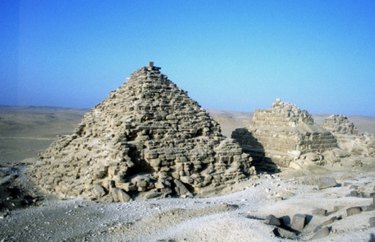
Ancient Mesopotamia pre-dates ancient Egypt by approximately 2,000 years; according to Washington State University, the first ancient Mesopotamian settlements date to around 5,000 BCE, whereas the first ancient Egyptian civilizations date from around 3,000 BCE. The art and architecture of the ancient civilizations share a few common characteristics, such as depictions of people and royal figures, but differ in many ways as well. Ancient figurines and pots with geometrical art have been found in Mesopotamia, whereas ancient Egyptian art consisted more of adorned architecture.
Step 1
Research some of the more instrumental pieces of art from both ancient cultures. The University of Chicago's Oriental Institute offers collections of ancient Mesopotamian art whereas the University of Memphis offers information and photographs of ancient Egyptian pieces.
Video of the Day
Step 2
Analyze trends in ancient Mesopotamian art pieces. Many of the pieces depicted on the University of Chicago website consist of figurines. The first piece listed on the site is a figurine of King Ur-Nammu, who enriched one of the temple, or E-kur, of Enlil, one of the most important gods. There are also figurines of a random female and statuettes of Sumerians kneeling in front of gods.
Step 3
Compare and contrast this with similar ancient Egyptian art pieces. Ancient Egyptian art often depicted Egyptians and Egyptian kings as well, but on a larger scale. Ancient Egyptian kings, such as Ramses II, are often depicted in larger-than-life statues outside of temples, such as at the temple at Amarna. The statuette of Sumerians kneeling share one similarity with the statues of Egyptian art: the eyes are large and rimmed in black.
Step 4
Compare and contrast the temples built by ancient Mesopotamians and ancient Egyptians. Fairfield University shows pictures of Sumerian temples on its site dedicated to ancient Mesopotamian architecture. Sumerian temples contained an outside retaining wall and stairs leading up to a wide plaza and a temple building, much like the ancient temples in Jerusalem. Ancient Egyptian temples, by contrast, tended to sport large statues of pharaohs at the entrance and then rows of columns inside.
Step 5
Note that both ancient Mesopotamian art and ancient Egyptian art contained steles with depictions of people or animals. The University of Chicago's website offers a photo of a stele of a lion that adorned the Processional Way out of Babylon. The ancient Egyptians also painted reliefs on columns and in the tombs of their pharaohs.
Step 6
Observe that pyramids are unique to ancient Egyptians; though there are pyramids in ancient Mesoamerican cities, the ancient Mesopotamians did not build pyramids.
Tip
Large art museums are good places to study ancient Mesopotamian and Egyptian art and architecture. The Metropolitan Museum of Art in New York, for example, has an entire large room dedicated to ancient Egyptian art pieces.
Warning
Ancient Mesopotamia and ancient Egypt were two very different civilizations. Mesopotamia sported many more cities spread over a wider area, while ancient Egypt was confined to the Nile valley, with few cities and more smaller groups spread along the river.
Video of the Day
- The University of Chicago: Oriental Institute: Highlights from the Collection: Mesopotamia
- Essential Humanities: Egyptian Art
- The University of Memphis: Institute of Egyptian Art & Archaeology
- Fairfield University: Architectural Marvels of Ancient Mesopotamia
- Washington State University: World Civilizations Department: Mesopotamian Timeline